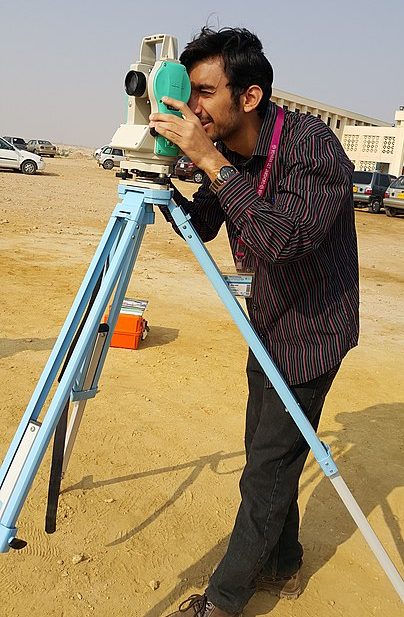
Theodolite surveying is that branch of surveying in which theodolite is used to measure the horizontal and vertical angles.
A Theodolite is a very precise instrument, mainly used for determining the horizontal and vertical distances between two points. It can also be used for prolonging a line, measuring distances indirectly, as a level, like a tachometer. Due to its wide range of applications, it is also termed as “Universal Instrument”.
Types of Theodolite:
There are generally two types of Theodolites:
- Transit Theodolite: A transit Theodolite is the one in which the telescope mounted in the instrument can be revolved through a complete revolution about its horizontal axis, in a vertical plane.
- Non-Transit Theodolite: It is the opposite of Transit Theodolite. In this type of Theodolite, the telescope can not be revolved through a complete revolution about its horizontal axis, in a vertical plane. It can be rotated to a certain extent to take vertical angles.
Theodolites can also be classified into two categories on the basis of the Scale used in theodolite as:
- Vernier Theodolite: it is fitted with a Vernier Scale. Vernier Theodolites are most commonly used in normal Surveying operations
- Micrometre Theodolite: Fitted with a micro micrometre scale
- The size of Theodolites is defined according to the diameter of its main scale, such as a 10 cm theodolite means that the diameter of its main scale is 10cm.
- In a survey, 8 cm to 12 cm theodolites is generally used.
Important Parts of the Theodolite & Their Functions

To understand the instrument, it is necessary to know about the parts, the instrument is composed of. These parts are given in as follows:
- Telescope: The telescope of theodolite is mounted on the horizontal spindle. It can be rotated about the horizontal axis to sight the objects. The telescope is internal focusing type i.e. the objective lens is fixed in the position and an additional double concave (focusing lens) is moved between the diaphragm and the objective.
- Vertical Circle: The vertical circle is rigidly fixed with the telescope, and moves along with it. It is subdivided into four quadrants, each quadrants having a reading of 0° to 90° in proper directions. The vertical circle also consists of a scale which is generally used for taking vertical angular measurements.
- Clamp Screws: Vertical clamp screw is used to clamp the telescope and vertical circle at any desired angle. It prevents the rotation of the telescope about the horizontal axis. These are situated in the lower plate of the instrument mostly and are used in rotating the instrument about its horizontal axis. These are two clamp screws, Lower clamp screw, generally used for rotating the whole instrument, and Upper clamp screw, which is used to fix the Vernier A and Vernier B to a certain degree (mostly 0° and 180°) by rotating the upper part of the instrument.
- Plate Bubble: Two plate bubbles are mounted at the upper surface of the Vernier plate at right angles. One plate bubble is kept parallel to the horizontal axis of the Theodolite and is used for horizontal levelling of the instrument. Another plate bubble is mounted about the vertical axis of the Theodolite and is used for vertical levelling of the instrument.
- Trivet: Trivet is the lowermost part of the instrument. It consists of a circular plate having a central, threaded hole in its centre, to properly fix the instrument with tripod stand. This plate is also termed as Base Plate. The foot Screws are attached over this plate with a ball and socket arrangement.
- Foot Screws: These are also termed as levelling screws, and are used to properly level the instrument in the ground. There is three number of foot Screws, which are rotated in a certain direction, to level the instrument.
- Tangent Screws: The instrument consists of two tangent screws, one of which is placed in the lower plate, and another one is placed in the upper plate. The lower tangent screw is used for very slight movement of the crosshairs to accurately bisect the ranging rod placed at the point, and the Upper tangent screw is used for very slight movement of the scale reading. Both screws are for accurate measurement purposes.
- Vernier Scales: Two Vernier scales are naming, horizontal scale & vertical scale. The horizontal scale is used for taking horizontal angles and is mounted on the lower plate of the instrument, and the vertical scale is used for taking vertical angles, fixed on the vertical circle.
Telescope Normal
The theodolite is called telescope normal when the vertical circle is to the left-hand side of the surveyor and the bubble tube on the telescope is upward.
Telescope Inverted
The theodolite is called telescope normal when the vertical circle is to the right-hand side of the surveyor and the bubble tube on the telescope is downward.
Transit
The process of rotation the telescope of theodolite by 180-degree about the horizontal axis (i.e. in the vertical plane) is called Transit of a theodolite.
This makes the telescope point in the exact opposite direction. It is also called reversing or plunging.
Swinging
The process of revolving the telescope of theodolite about the vertical axis (i.e. in the horizontal plane) is called swing or swinging of the telescope.
A right swing implies the clockwise rotation of theodolite and a left swing implies anticlockwise rotation.
Changing Face
The process of bringing the telescope from the face left position to the face right position or vice-versa is called changing face.
The face can be changed by reversing the theodolite (transit) and rating it by 180-degree(swing) operations.
Temporary Adjustments of a Theodolite
The activities required at every setting of the theodolite at a station before taking the observations is called temporary adjustments of a theodolite. It includes:
Setting up
Procedure for setting up the theodolite:
- Place the tripod over the required station.
- Spread the legs of tripod such that they make an angle of about 60-degree with horizontal.
- Push the shoe of each tripod leg into the ground by applying some force.
- Take the theodolite out from its box. Lift it from the base and screw it tightly on the tripod.
Centring
Centring is done to place the theodolite exactly above the station. The Centering is done using a plumb Bob and a nail. The nail is fixed at the exact point the instrument is to be placed. The Plumb Bob is suspended from a hook, fixed below the instrument. Then the legs of the tripod should be adjusted to place the suspended plumb bob, just over the exact point.
Levelling
The levelling of theodolite is done to make the vertical axis of the theodolite truly verticle or to make horizontal plane truly horizontal.
This can be done by placing the horizontal bubble tube parallel to any two of the foot screws and then rotating the foot screws in opposite direction to bring the bubble at the centre.
After the bubble has been placed into the centre, it is then placed to the perpendicular of its initial position. Then the third foot screws are rotated at either direction to bring the bubble at the centre. These procedures should be repeated several times until the bubble is completely centred. The same procedure should be adopted in case of the vertical bubble tube.
Focussing the Eye-Piece
The eyepiece of theodolite is focused to make the crosshairs in diaphragm clear and distinct. It depends upon the eyesight of the surveyor.
- Point the telescope of theodolite towards the sky or put a white paper in front of the objective lens.
- Move the eyepiece in or out by rotating it gradually until the crosshairs appear clear.
Focussing the Objective
The objective of theodolite s focussed to bring the image of the object in the plane of crosshairs (diaphragm). It is done with help of focusing screw. It depends upon the distance of the object.

Measurement of a Horizontal Angle by Theodolite
Horizontal angles can be done by two methods:
- Repetition Method
- Reiteration method.
Repetition method is used mostly in measuring the horizontal angles.
Procedure:
- Centring: After the instrument is levelled properly, it is then centred.
- After Centering is done, Vernier A is fixed at 0° and Vernier B is fixed at 180°, by loosening the upper clamp screw. By turning the upper tangent screw, Vernier A & B are accurately fixed into its readings.
- The upper clamp screw is then tightened, and the lower clamp is loosened. The instrument is rotated to bisect the ranging rod at one point. The lower tangent screw is used for accurately dissecting the ranging rod.
- The lower clamp screw is then tightened, and the upper clamp screw is loosened. By turning the telescope in a clockwise direction, about its horizontal axis, the ranging rod at other point is bisected. The reading at scale is to be noted.
- These steps should be repeated thrice, the average value should be taken.
Measurement of a Verticle Angle by Theodolite
This is another important anti function of a Theodolite, and it is the only manual instrument using which vertical angles should be taken. The procedures of taking vertical measurements are as below:
Procedures:
- Levelling and Centering of the instrument are done following the above-mentioned methods.
- The Vernier A & Vernier B of the vertical scale is to fixed at 0° and 180° respectively.
- The telescope is targeted towards the point from which vertical angle is to be taken. Tangent screws are used for accurate bisection of the ranging rod at that point.
- Then the telescope is rotated in a vertical plane to bisect the point at some certain elevation.
- After the bisection of the point, the telescope is to be fixed, and the reading is taken, which is the required angle of elevation.
Measurement of a Deflection Angle by Theodolite
While surveying, change in direction of the survey line may often occur, due to identification of some obstacles, such as building, factories, etc. The deflection angle is that angle which is formed between the extension of the previous survey line, with the new survey line. Deflection angles hold a great value in Surveying operation, as it determines the angle, the existing survey line is to be deflected.
The procedure for determining the Deflection angle is given below:
Procedure:
- The levelling and Centering of the instrument are to be done.
- A point Is fixed on the extension line and another point is fixed on the new survey line. The instrument is placed at a position from where, both the points are visible.
- The upper clamp is loosened, and the Vernier A & B are fixed at 0° and 180° respectively. Then the upper clamp is tightened.
- By loosening the lower clamp screw the point at the extension line is bisected. The lower clamp is then fixed.
- By loosening the lower clamp screw, the instrument is turned clockwise, and the point situated at the new survey line is bisected. Tangent screws are used for accurate bisection.
- The reading is to be taken
Measurement of Magnetic Bearing by Theodolite
Theodolites are also used for measuring the magnetic bearings. The procedure is as follows:
Procedure:
- Centring and Levelling of the instrument are to be done.
- The Vernier A & B are fixed at 0° and 180°, respectively, by the above-mentioned process.
- A trough compass or circular compass is to be fitted with the instrument, using which, the north direction is to be determined. After that, the instrument to set into the north direction by loosening the lower clamp screw. This is known as Orientation.
- After that, the point is bisected using the upper clamp screw. The value obtained is the required magnetic Bearing of that point.
Ranging a Line using a Theodolite
Theodolites can also be used for ranging a line accurately.
Procedure:
- Levelling & Centering of the instrument is to be done.
- The telescope is directed towards the point which is to be ranged. After that, the observer directs the follower to place a ranging rod between the two points, by giving him proper commands. After the crosshairs perfectly bisect the ranging rod, the ranging rod is to be fixed at that point, thus finishing the ranging operation.
References:
Learn more about Civil Engineering:

